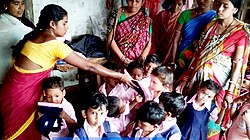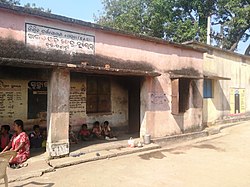Anganwadi
This article's factual accuracy may be compromised due to out-of-date information. (July 2020) |
| Formation | 1975 |
|---|---|
| Founder | Government of India |
| Type | Governmental organization |
| Legal status | Governmental organization |
| Purpose | combat hunger and malnutrition of children. |
| Origins | India |
| Affiliations | Government of India |
Anganwadi is a type of rural child care centre in India. They were started by the Indian government in 1975 as part of the Integrated Child Development Services program to combat child hunger and malnutrition. Anganwadi means "courtyard shelter" in Hindi.
A typical Anganwadi center provides basic health care in a village. It is a part of the Indian public health care system. Basic health care activities include contraceptive counseling and supply, nutrition education and supplementation, as well as pre-school activities.[1] The centres may be used as depots for oral rehydration salts, basic medicines and contraceptives. As of 31 January 2013[update], as many as 13.3 lakh (a lakh is 100,000) Anganwadi and mini-Anganwadi centres (AWCs/mini-AWCs) are operational out of 13.7 lakh sanctioned AWCs/mini-AWCs. These centres provide supplementary nutrition, non-formal pre-school education, nutrition, and health education, immunization, health check-up and referral services of which the last three are provided in convergence with public health systems.[2]
Worker responsibilities[edit]
The Ministry of Women Development and Child Welfare has laid down guidelines for the responsibilities of Anganwadi workers. These guidelines include showing community support and active participation in executing this program, conducting regular quick surveys of all families, organizing pre-school activities, providing health and nutrition education to families, especially pregnant women, motivating families to adopt family planning, educating parents about child growth and development, assisting in the implementation and execution of Kishori Shakti Yojana, educating teenage girls and parents by organizing social awareness programs, and identifying disabilities in children.
Supervision[edit]
A Mukhya Sevika supervises between 40 and 65 Anganwadi workers, providing them with on-the-job training. Mukhya Sevikas' other duties include keeping track of people of lower economic status benefiting from the program, in particular the malnourished; guiding the Anganwadi workers in assessing children's age and weight and plotting their weight; demonstrating effective methods of providing health and nutrition education to mothers; and maintaining statistics on Anganwadis and their workers to determine what can be improved. The Mukhya Sevikas report to the Child Development Projects.
Benefits[edit]
Despite decades of impressive growth, India has an acute shortage of doctors.[3] The doctor population ratio in 2013 was 1:1800; the recommended level is 1:1000.[4] Through the Anganwadi system, the country is trying to meet its goal of providing affordable and accessible healthcare to local populations.
Anganwadi workers have the advantage over the physicians living in the same rural area, which gives them insight into the state of health in the locality and assists in identifying the cause of problems and in countering them. They also have better social skills and can therefore more easily interact with the local people.[citation needed] As locals, they know and are comfortable with the local language and ways, are acquainted with the people, and are trusted.[5]
Challenges and solutions[edit]
Public policy discussions have taken place over whether to make Anganwadis universally available to all eligible children and mothers who want their children there. This would require significant increases in budgetary allocation and a rise in the number of Anganwadis to over 16 lakh.
The officers and their helpers who staff Anganwadis are typically women from poor families. The workers do not have permanent jobs with comprehensive retirement benefits like other government staff. Worker protests (by the All India Anganwadi Workers Federation) and public debates on this topic are ongoing. There are periodic reports of corruption and crimes against women in some Anganwadi centers.[6][7] There are legal and societal issues when Anganwadi-serviced children fall sick or die.[8]
In announcing the 2008-2009 budget, then Indian Finance Minister P. Chidambaram stated that salaries would be increased for Anganwadi workers to ₹15000 per month and for helpers to ₹6500 per month.[citation needed] In his budget speech for the financial year 2011-2012, his successor Pranab Mukherjee announced that the salary of Anganwadi workers would be increased to ₹3000 per month and for helpers to ₹1500 per month — about one tenth of the salary of a government office assistant.[citation needed]
In March 2008 there was debate about whether packaged foods (such as biscuits) should become part of the food served. Detractors, including Nobel Prize winner Amartya Sen, argued against it, saying thajt it will become the only food consumed by the children. Options for increasing partnerships with the private sector are continuing.
In a major initiative, the work of Anganwadis is to be digitized, starting with the 27 most-backward districts in Uttar Pradesh: Bihar, Madhya Pradesh, Rajasthan, Odisha and Andhra Pradesh. Anganwadis will be provided with tablet computers to record data that will be integrated with the health ministry, which is involved in carrying out immunization, health check-ups, and nutrition education under Integrated Child Development Services.
Integration with other official schemes[edit]
The Integrated Child Development Services scheme did not have provision for the construction of AWC buildings as this was envisaged to be provided by the community except for the North Eastern States. For them, financial support was provided for construction of AWC buildings since 2001-02 at a unit cost of ₹175,000.
As part of the strengthening and restructuring the ICDS scheme, the government approved a provision of construction of 200,000 Anganwadi centre buildings at a cost of ₹450,000 per unit during XII Plan period in a phased manner with a cost-sharing ratio of 75:25 between centre and states (other than the NER, where it will be at 90:10).
Further, construction of AWC has been notified as a permissible activity under the Mahatma Gandhi National Rural Employment Guarantee Act (MNREGA). The construction of AWC buildings can be taken up in convergence with MNREGA.[9]
International efforts[edit]
UNICEF and the UN Millennium Development Goals of reducing infant mortality and improving maternal care are the impetus for increasing focus on the Anganwadis.[citation needed] Workers and helpers are expected to be trained per WHO standards.
See also[edit]
References[edit]
- ↑ National Population Policy 2000 Archived 7 February 2012 at the Wayback Machine, National Commission on Population website. Accessed 13 February 2008
- ↑ "Anganwadi Centres".
- ↑ Amy Kazmin. "Doctors are scapegoats for India's failing health system". Financial Times. Retrieved 7 November 2018.
- ↑ Deo, Madhav (2013). "Doctor population ratio for India - the reality". Indian Journal of Medical Research. 137 (4): 632–5. PMC 3724242. PMID 23703329.
- ↑ "The Anganwadi Workers of India". Health Opine. 3 March 2011. Archived from the original on 31 March 2012. Retrieved 31 October 2011.
- ↑ "2 held, 6 booked for graft in Rs 18 crore anganwadi tender". The Times of India. Retrieved 18 February 2019.
- ↑ "Anganwadi worker kidnapped, gang-raped in Odisha; 3 detained". Odisha Sun Times. Retrieved 18 February 2019.
- ↑ "Tragedy strikes anganwadi again". The Times of India. 8 September 2012. Retrieved 30 March 2019.
- ↑ "Anganwadi Centres". Ministry of Women and Child Development, Government of India. Retrieved 30 March 2016.









